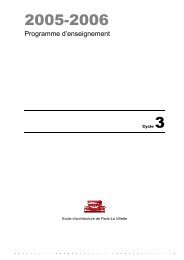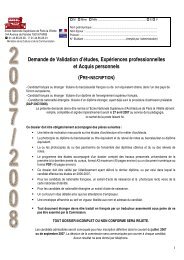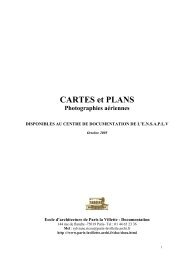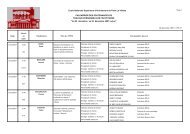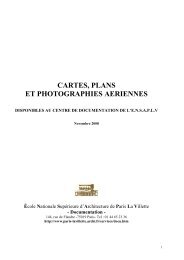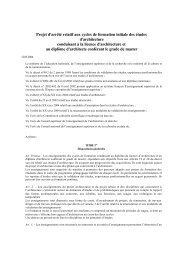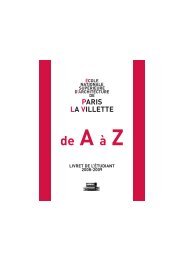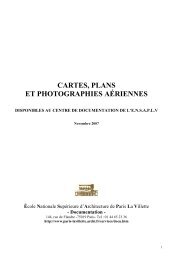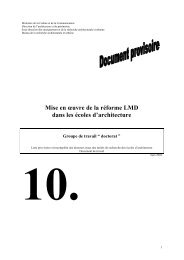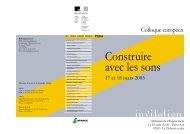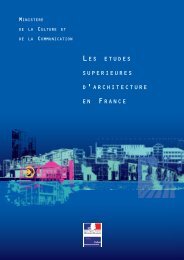Transmitting the past to the future : - Ecole Nationale Supérieure d ...
Transmitting the past to the future : - Ecole Nationale Supérieure d ...
Transmitting the past to the future : - Ecole Nationale Supérieure d ...
You also want an ePaper? Increase the reach of your titles
YUMPU automatically turns print PDFs into web optimized ePapers that Google loves.
4<br />
nowadays, i.e. that of a material building of remarkable size and/or age; and only in <strong>the</strong> 20 th<br />
century did whole sets of material buildings, i.e. urban environments, acquire <strong>the</strong> status of<br />
his<strong>to</strong>rical monuments, as such <strong>to</strong> be protected and preserved in <strong>the</strong>ir initial forms. That is, frozen.<br />
3. The limits of <strong>the</strong> modern Western paradigm<br />
This modern transformation corresponds <strong>to</strong> <strong>the</strong> on<strong>to</strong>logical shift, analysed by Martin Heidegger<br />
(1889-1976) in Sein und Zeit (1927), from Geschichtlichkeit <strong>to</strong> His<strong>to</strong>rischkeit; that is, from lived his<strong>to</strong>ry<br />
<strong>to</strong> objectified his<strong>to</strong>ry. In o<strong>the</strong>r words, it corresponds <strong>to</strong> <strong>the</strong> emergence of modern dualism. It is<br />
this shift which made possible <strong>the</strong> emergence of <strong>the</strong> respect of ancient built environments as<br />
his<strong>to</strong>rical monuments, and which, consequently, brought forth modern conservational policies<br />
such as those advocated by <strong>the</strong> UNESCO's convention of 1972.<br />
Now, <strong>the</strong>re is an essential contradiction in this attitude; because it supposes, on <strong>the</strong> one<br />
hand, <strong>the</strong> capacity <strong>to</strong> recognize <strong>the</strong> proper his<strong>to</strong>rical value of certain built forms, that is, <strong>the</strong><br />
intrinsic value of objects, as distinct from <strong>the</strong> subjective interests of contemporary people, while<br />
on <strong>the</strong> o<strong>the</strong>r hand it is advocated in <strong>the</strong> name of <strong>the</strong> cultural identity of those same people; that is,<br />
it implies a negation of that very dualism which made possible <strong>the</strong> emergence of <strong>the</strong> modern<br />
notions of monument and heritage.<br />
A good example of this aporia can be found in a reflection made in 1987 by Mrs Choay at<br />
<strong>the</strong> occasion of a bilateral, French and Japanese symposium on La Qualité de la ville / Toshi ni kosei<br />
wo 都 市 に 個 性 を (The quality of <strong>the</strong> city): "Whe<strong>the</strong>r prevails <strong>the</strong> symbolic permanence of <strong>the</strong> form<br />
in space or that of <strong>the</strong> matter in time, in any case it is that same kind of conservation, universal<br />
and identifica<strong>to</strong>ry, which <strong>the</strong> question is about". 10 Choay's expression "<strong>the</strong> symbolic permanence<br />
of <strong>the</strong> form in space" alludes <strong>to</strong> <strong>the</strong> famous case of <strong>the</strong> temples of Ise shrine (Ise jingo 伊 勢 神 宮 ),<br />
in Japan, which are ritually rebuilt with new material (hinoki 檜 , or Japanese cypress) every<br />
twentieth year in <strong>the</strong>ir initial form, dating back <strong>to</strong> Antiquity. 11 She opposes this pratice of<br />
monumentality <strong>to</strong> <strong>the</strong> European one, in which preserving <strong>the</strong> au<strong>the</strong>nticity of <strong>the</strong> initial material is<br />
more important, be it in <strong>the</strong> form of ruins, that is, at <strong>the</strong> expense of <strong>the</strong> initial form. Though<br />
interesting and profound Choay's reflection may be, it remains <strong>to</strong>tally circumscribed within <strong>the</strong><br />
modern classical Western paradigm, that of Descartes and New<strong>to</strong>n, which presupposes <strong>the</strong><br />
universalness of space and time, and which <strong>the</strong>refore is about <strong>the</strong> form and/or <strong>the</strong> matter of<br />
objects. 12 Here lies <strong>the</strong> aporia, since, at <strong>the</strong> same time, Choay speaks of an "identifica<strong>to</strong>ry"<br />
function of such objects; which implies a transgression of <strong>the</strong> modern duality between subject<br />
and object. In Heideggerian terms, <strong>the</strong> identification of a society with its monuments belongs <strong>to</strong><br />
<strong>the</strong> dimension of <strong>the</strong> geschichtlich, and <strong>the</strong>refore has nothing <strong>to</strong> do with <strong>the</strong> universalness of space<br />
and/or time, which on <strong>the</strong> contrary belongs <strong>to</strong> <strong>the</strong> dimension of <strong>the</strong> his<strong>to</strong>risch. In terms of<br />
Geschichtlichkeit, <strong>the</strong>re is nothing like "universal space and/or time", which is an abstract, modern<br />
prerequisite for <strong>the</strong> existence of objects as such; what <strong>the</strong>re is, is <strong>the</strong> concreteness of things in <strong>the</strong><br />
"country" (Gegend) of existence, in which nei<strong>the</strong>r subject and object, matter and form, nor space<br />
and time, can be dissociated.<br />
As a matter of fact, <strong>the</strong> periodic reconstruction of Ise shrine is an exemplary expression<br />
of Geschichtlichkeit as an absolute negation of that his<strong>to</strong>rical distance which - as Choay herself has<br />
made clear - appeared in Europe at <strong>the</strong> Renaissance; because ancient forms are here indefinitely<br />
enacted as if <strong>the</strong>y were present forms. This is not all. Such enaction of <strong>the</strong> ancient through <strong>the</strong><br />
10 "Que prévale la permanence symbolique de la forme dans l'espace ou celle de la matière dans le temps, dans l'un et<br />
l'autre cas, c'est du même genre de conservation, universelle et identifica<strong>to</strong>ire qu'il s'agit". Françoise CHOAY,<br />
'Mémoire de la ville et monumentalité', in Augustin BERQUE (ed.) La Qualité de la ville. Urbanité française, urbanité<br />
nippone, Tokyo : Maison franco-japonaise, 1987, p. 123. For more comparisons of <strong>the</strong> monumentality of Ise with a<br />
European counterpart (namely <strong>the</strong> Roman <strong>the</strong>rms of Cluny in Paris), see Augustin BERQUE, Japan : Cities and Social<br />
Bonds, Yelver<strong>to</strong>ft Manor : Pilking<strong>to</strong>n, 1997 (Du Geste à la cité. Formes urbaines et lien social au Japon, Paris : Gallimard,<br />
1993), chap. I ('Devenir : ville japonaise, espace-temps'), and Augustin BERQUE, Toshi no kosumorojî. Nichi-Bei-Ou<br />
<strong>to</strong>shi hikaku, 都 市 のコスモロジー. 日 米 欧 都 市 比 較 , Tokyo : Kodansha gendai shinsho, 1993, chap. I<br />
('Yurianusu no yokujô <strong>to</strong> Ise jingû ユリアヌスの 浴 場 と 伊 勢 神 宮 ').<br />
11 The shrine originates in <strong>the</strong> transfer of <strong>the</strong> cult of <strong>the</strong> Sun goddess Amaterasu Oomikami 天 照 大 神 from Yama<strong>to</strong><br />
大 和 <strong>to</strong> Ise <strong>to</strong>ward <strong>the</strong> end of <strong>the</strong> 5 th or <strong>the</strong> beginning of <strong>the</strong> 6 th century. The rite of reconstructing <strong>the</strong> main temple<br />
every twentieth year was established under <strong>the</strong> reign of Temmu ( 天 武 , died in 686).<br />
12 For an interpretation of this same problem in terms of his<strong>to</strong>ry of science, see Alexandre KOYRE's classical study<br />
From <strong>the</strong> closed world <strong>to</strong> <strong>the</strong> infinite universe, Baltimore : John Hopkins Press, 1957.



